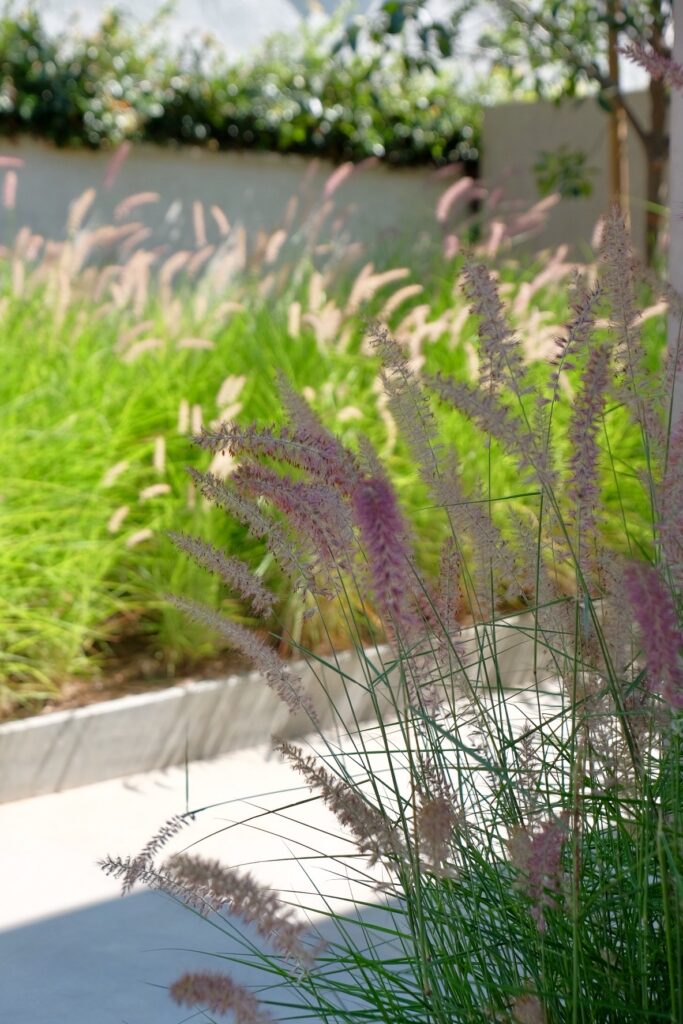How to trim ornamental grasses – a neat and simple method that won’t leave you scrambling to clean up after you’re done.
Ornamental grasses are a great addition to any garden, but they can quickly become overgrown and unsightly if not trimmed regularly. In this blog post, we will discuss the best practices for trimming ornamental grasses to keep your garden looking its best.

Ornamental grasses are a popular choice for many gardeners because they are low-maintenance and add texture and interest to any landscape. However, if left untrimmed, they can become an eyesore and detract from the beauty of your garden. Trimming ornamental grasses is an important task that should be done at least once a year to keep them looking their best.
When to Prune Ornamental Grasses
There are really two good times to prune ornamental grasses.
The simplest approach would be to prune in the fall after your grasses start to dry and turn color.
The second approach, and the one I recommend, is to wait until you see new growth in the spring. In California this is usually January. The nice thing about this pruning method is that you’re leaving the seed heads and the leaves as food and shelter for the native birds and insects. Plus, dried grasses can be very sculptural and add visual interest over the winter.
Piet Oudolf makes good use of this in his meadow gardens.
Tools Required
Before you begin trimming your ornamental grasses, you will need a few tools:
- Natural Twine (or bungee cord)
- Pruning Shears, Hedge clippers or Loppers – don’t forget to put a nice hone on the blade with your sharpening steel.
- An Olfa snap off utility knife
- Cotton painters drop cloth.
- Gloves (optional)
I also like to have my hori hori garden knife with me no matter what garden task I’ve started out on…

Step-by-Step Guide
working time: 1 – 2 hrs
total time: 1 – 2 hrs
skill level: beginner
estimated cost: $0
Let’s Get Started
Gather your tools and put on gloves (or not – if you’re feeling lucky!).
Note: be sure to wear long sleeves when working with grasses. Some of them have sharp edges that can, and will, abrade your arms if you let them.
Instructions:
Begin by combing the grass
- Rake your gloved fingers (or a hand rake gardening tool) through the middle of the clump grabbing all the dead and loose dried up grass leaves.
- Comb through the entire mass of grass and shake it periodically, this will extract more dried plant material. You may accumulate a considerable pile of dead material, which you can throw on top of the drop cloth as you move through the garden.
Tie up your grasses
- Wrap twine or bungee cord around the base of the grass.
- Make sure it’s nice and tight while also leaving enough room for you to cut the grass a few inches beneath the bottom of the cord so that the tie can keep things secured together.
- The nice thing about natural twine is that the whole bunch can now be collected on your drop cloth and brought to be composted.
Trim below the cord
- Next use your pruning shears to cut through the grass.
- Grasses that are taller than three feet should be cut back to four to six inches from ground level. Shorter mature plants can be cut back to about three inches.
- When you’re done, if it’s jute, hemp, or another natural twine you can toss the bundles onto the drop cloth. If you’d rather you can untie them and dump the cutting loose and reuse the twine.
- When you have a good load, grab the corners of the drop cloth and drag it over to your compost area or to dispose as required.
For quick trims
You can also grab a bunch of grass in your hand and cut above or below. You’ll have to repeat this several times, but it works and may be easier for quick touch-ups. Instead of the drop cloth, I sometimes just bring a 5 gal bucket around if I’m just trimming up a bit.
Pruning goals
It’s important to aim for clumps that look well-groomed but not overdone. To achieve this, take a step back from your work occasionally to assess the result. Stop pruning when you achieve an appearance that is neat and natural.
Cutting and grooming ornamental grass is essential for its healthy growth. By removing all the dry, old growth that is essentially a big mess of dead grass, new growth will be exposed to sunlight and fresh air, which is crucial for its health. If you are compelled to cut ornamental grass very short, do not trim it any lower than 4 inches from the ground – but generally removal of the dry blades and a good shaping is all that will be needed.
Conclusion
If you perform ornamental grass pruning as laid out above, it will keep things clean and healthy in two ways. First, it will prevent the grass from falling all over the place which will make it harder to collect and tidy up before throwing it away. Secondly, it allows you to cut the grass in a nice, clean line and leaves you with a neat looking winter garden that will be ready to grow again during the next growing season.
